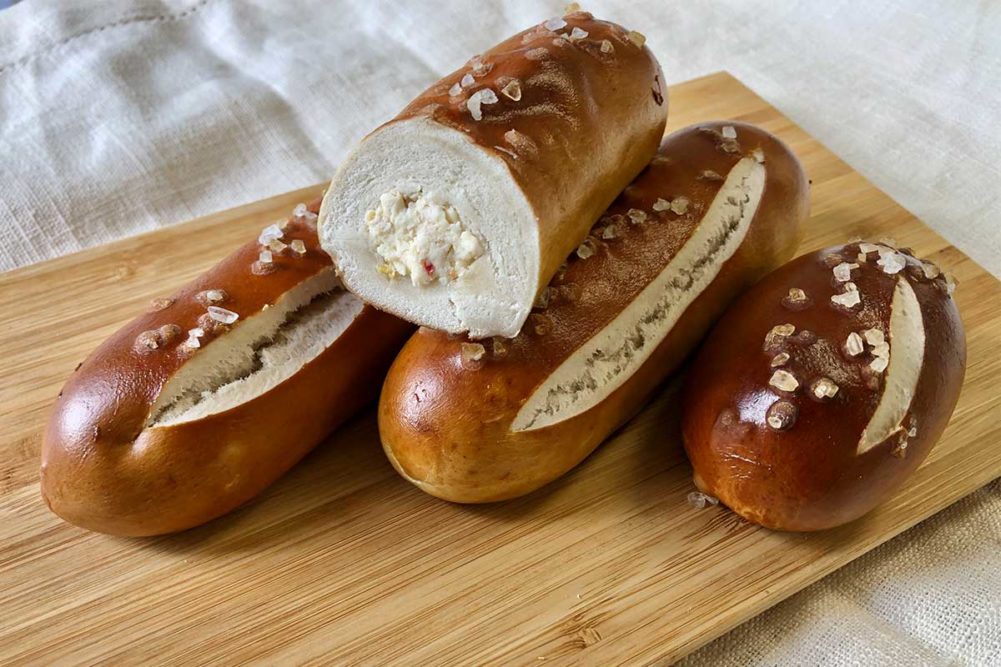Smaller pretzels, whether called bites or nuggets, have had a moment thanks to a more food safety-conscious consumer.
“Ever since COVID, the bites have taken off because when you buy a 16-oz pretzel, everyone has to tear it apart and touch it,” said said Matt Zielsdorf, director of sales for Fritsch, a Multivac Group company. “If you buy bites, everyone can touch just their own.”
Because of their size, however, pretzel bites can encounter issues of flow and product orientation as they are transferred from one process to another, especially in the lye process. This can cause issues of discoloration.
“A standard soft pretzel, typically 5 oz, rides the bath nicely,” Mr. Zielsdorf explained. “The bites get caught in the bath and get too wet, which makes them turn out bitter and too dark.”
Also, during the transfer, if automatic pan retraction is done incorrectly, Mr. Zielsdorf said pretzel bites can bounce and get stacked.
“If they are touching when they go into the lye bath, the coloring will also be off, and the entirety of the product will not be getting the lye bath,” he said.
Filled pretzels are also showing some staying power. These products, both soft and hard, are a versatile, value-added product. The filling adds a premium to the humble pretzel, and snack makers can get creative in the fillings they offer.
“Fillings can be anything from sweet to savory,” said. “The taste of a soft pretzel dough lends itself very well to many different filling types. A filled pretzel is also considered a value-added product that can bring better margins and value to the manufacturer.”
Co-extrusion also eases the processing side of developing new products, opening the doors for snack manufacturers to get creative.
“With a co-extruded product, it is usually very easy to develop new products just by changing the filling flavor profile,” said John Giacoio, vice president of sales, Rheon USA. “This allows for line extensions once a product has been accepted into the market and is doing well.”
The key to successful filled pretzels is a stable filling and consistent dough, said Lipika Mandal, food technologist, Spooner Vicars, a Middleby Bakery company.
“The major challenges we face is the oozing out of the filling,” she said. “This usually happens when the filling specs are not in place. For example, filling may start boiling within when exposed to baking if the filling is not bake-stable. Even the dough needs to be properly sealed so that while extrusion is happening, the filling should not be coming out.”
Fillings do offer pretzel manufacturers the opportunity to get creative, but not all fillings are created equally, especially when it comes to the critical bake stability.
“In a world looking for more than just peanut butter-filled pretzels, pretzel makers need to be careful with what they put inside a pretzel,” said Nico Roesler, North American pretzel and snack equipment sales manager, Reading Bakery Systems (RBS). “The fillings not only need to taste good, but they also need to be processable, bake stable and shelf life stable.”
In addition to boiling, a filling that cannot handle the high temperatures of the oven can burn or dry out too much, resulting in a less than desirable eating experience. There are also safety concerns to consider.
“Together with ensuring proper seal on the nugget shell, you need to make sure the filling doesn’t run out of the product because of its high fat or oil content,” he said. “If oil or fat blow out of the product, it can create a mess on the oven belt and eventually create a fire hazard if that filling isn’t regularly cleaned off the belt.”
This challenge exists in the world of filled soft pretzels, too. Mr. Giacoio noted that when fillings are fully encapsulated in dough, it’s critical that their water content is reduced as much as possible.
“Excess water can cause steam during the baking process and blowouts can occur,” he said. “Excess water can also impact shelf life. It’s always a careful balance of flavor between filling and the pretzel dough so both are enjoyed.”
Even when a filling is completely encapsulated, Mr. Giacoio said the steam created by excess water could cause the pretzel dough to break open. While docking the product would allow steam to escape, he said most snack manufacturers aren’t looking for that presentation in their final product. Removing water from the filling is the strategy most snack makers choose to go with.
“As you take water out of the product, the filling becomes more concentrated, so many times less filling can be used to achieve the same taste profile,” he said.
This article is an excerpt from the October 2023 issue of Baking & Snack. To read the entire feature on Pretzel Processing, click here.





